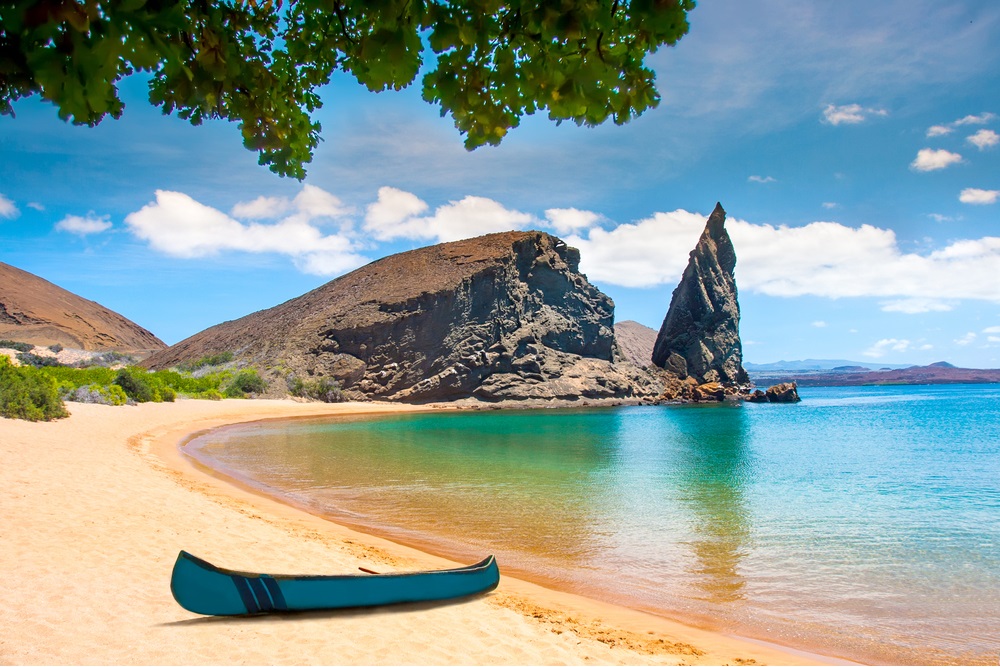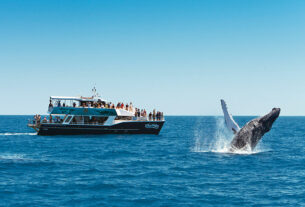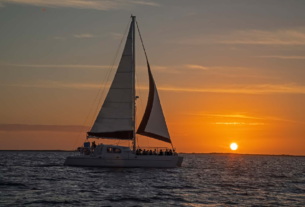Key Takeaways:
- The Galapagos Islands are home to unique and diverse wildlife
- Darwin’s research on the islands influenced his theory of evolution
- The islands are known for their giant tortoises and marine iguanas
- The Galapagos offer opportunities for snorkeling and scuba diving
- Visitors can sail through the archipelago to explore multiple islands
- Hiking trails provide immersion in the islands’ pristine nature
- The Galapagos played a significant role in the development of Darwin’s theory of evolution
- The islands have experienced both natural changes and human impact
- Conservation efforts are in place to protect the fragile ecosystem
- Factors to consider when planning a trip include the best time to visit and choosing the right cruise or accommodation
- Essentials to pack for a trip to the Galapagos include sun protection, comfortable footwear, swimwear, and a respectful travel mindset.
In this guide to Galapagos travel, you will learn more about the island and what you can expect.
1. Discover the Unique Wildlife of the Galapagos Islands
The Galapagos Islands, a volcanic archipelago in the Pacific Ocean, are home to some of the world’s most unique and diverse wildlife. The isolation of the islands, combined with their diverse ecosystems, has allowed for the evolution of species found nowhere else on Earth. From giant tortoises to marine iguanas, the Galapagos is a treasure trove for nature lovers and wildlife enthusiasts.
1.1. The Evolutionary Wonders of the Galapagos
The Galapagos Islands are often referred to as a living laboratory of evolution. This is due to the famous research conducted by Charles Darwin during his voyage on the HMS Beagle in the 19th century. Darwin’s observations and collections from the Galapagos significantly developed his theory of evolution by natural selection.
One of the most fascinating aspects of the Galapagos wildlife is the process of adaptive radiation, where a single species diversifies into multiple species to adapt to various ecological niches. This can be seen in Darwin’s finches, a group of thirteen species of finches that vary in beak size and shape, allowing them to feed on different food sources.
Another example of an evolutionary wonder in the Galapagos is the marine iguana. These unique creatures have adapted to their marine environment by developing a flattened tail for swimming and special glands to expel excess salt from their bodies. They are the only iguanas in the world that can forage in the sea.
1.2. Encounter the Famous Galapagos Giant Tortoises
No visit to the Galapagos would be complete without encountering the famous giant tortoises. These majestic creatures are one of the most iconic symbols of the Galapagos Islands. They can live for over a century and weigh up to 500 pounds.
The tortoises on different islands of the Galapagos have adapted to the specific conditions of their habitats. For example, the tortoises on Santa Cruz Island have longer necks to reach food sources that are higher off the ground, while those on Isabela Island have larger shells to protect against predators.
Visitors to the Galapagos can see these incredible creatures up close during guided tours of the islands. As these tortoises are protected species, it is important to respect their natural habitats and follow the guidelines provided by the National Park.
1.3. Dive into the Underwater Paradise: Marine Life in the Galapagos
The Galapagos Islands are not just famous for their land-based wildlife but also for their rich marine life. The surrounding waters are teeming with diverse marine species, making the Galapagos a world-class destination for snorkeling and scuba diving.
Snorkelers and divers can expect to encounter playful sea lions, graceful sea turtles, and schools of vibrant tropical fish. One of the highlights of diving in the Galapagos is the chance to spot hammerhead sharks, manta rays, and even whale sharks, the largest fish in the world.
For experienced divers, there are also opportunities to explore underwater volcanic formations and dive with marine iguanas. The Marine Reserve in the Galapagos ensures that these underwater ecosystems are protected, allowing visitors to witness the beauty of the marine world while preserving it for future generations.
2. Unforgettable Adventures in the Galapagos
Beyond its unique wildlife, the Galapagos Islands offer many unforgettable adventures for travelers. Whether sailing through the archipelago, hiking along pristine trails, or exploring the vibrant underwater world, there is something for everyone in this natural paradise.
2.1. Sail the Galapagos Archipelago: A Once-in-a-Lifetime Experience
One of the best ways to experience the Galapagos is by sailing through the archipelago on a cruise ship or a smaller yacht. This allows travelers to visit multiple islands and explore their distinct ecosystems and wildlife. Along the way, experienced guides provide insights into the Galapagos’ history, geology, and biology.
Visitors can enjoy activities such as snorkeling, kayaking, and hiking during a cruise. They can also relax on pristine beaches and witness breathtaking sunsets over the Pacific Ocean. The Galapagos National Park regulates the number and routes of cruise ships, ensuring minimal impact on the fragile ecosystem.
2.2. Hiking Trails in the Galapagos: Immersion in Pristine Nature
For those who prefer a more active adventure, the Galapagos Islands offer a range of hiking trails that provide immersion in the islands’ pristine natural beauty. Trails are suitable for all fitness levels and interests, from rocky coastlines to lush highlands.
One popular hike is the Sierra Negra Volcano hike on Isabela Island. This trail takes visitors to the edge of the second-largest volcanic crater in the world, offering panoramic views of the surrounding landscape. Another popular hike is the Cerro Tijeretas trail on San Cristobal Island, which leads to a viewpoint overlooking the coastal cliffs.
Guided hikes are recommended to ensure visitors stay on designated paths and do not disturb the fragile ecosystems. Carrying water, sunscreen, and appropriate footwear for the hikes is also important.
2.3. Snorkeling and Scuba Diving: Exploring the Vibrant Underwater World
The Galapagos Islands are a paradise for snorkelers and scuba divers alike. The crystal-clear waters provide an opportunity to witness the diverse marine life up close and personal. With an average water temperature of around 70°F (21°C), the Galapagos offers comfortable conditions for underwater exploration.
Snorkelers can enjoy shallow reefs teeming with colorful fish and playful sea lions. Some popular snorkeling sites include Kicker Rock, Gardner Bay, and Devil’s Crown. The Galapagos offers even more thrilling experiences for those with scuba diving certification.
The underwater world of the Galapagos is home to various unique species, including marine iguanas, penguins, and several species of sharks. Diving enthusiasts can explore sites such as Gordon Rocks, Darwin Island, and Wolf Island, known for their abundance of marine life and thrilling drift dives.
3. The Galapagos Islands: A Window into Charles Darwin’s Theory of Evolution
The Galapagos Islands hold a special place in the history of science and our understanding of the natural world. During his voyage on the HMS Beagle in 1835, Charles Darwin made a series of observations that led to his groundbreaking theory of evolution by natural selection.
3.1. The Galapagos and Darwin’s Groundbreaking Discoveries
During his visit to the Galapagos, Darwin observed numerous species unique to each island yet sharing similarities with species found on the South American mainland. This led him to believe that these species had evolved from a common ancestor and adapted to their specific island environments over time.
One of the most famous examples of Darwin’s observations is the variation in the beak size and shape of the Galapagos finches. This variation allowed the finches to exploit different food sources, leading to the development of new species.
Darwin’s observations in the Galapagos challenged the prevailing belief in the fixity of species and laid the groundwork for his theory of evolution. His book “On the Origin of Species,” published in 1859, revolutionized our understanding of the natural world and profoundly impacted scientific thinking.
3.2. Revisiting the Galapagos: How Has the Archipelago Changed Since Darwin?
Since Darwin visited the Galapagos, the islands have experienced both natural changes and human impact. Some species, like the Florean mockingbird, have become extinct due to introduced species and habitat destruction. However, restoring and protecting ecosystems has led to successful conservation programs.
One notable success story is the Galapagos giant tortoise population. Hunting and introduced species brought these tortoises to the brink of extinction, but their numbers have increased significantly in recent decades through captive breeding and restoration efforts.
The Galapagos Islands are still a living laboratory for studying evolution, and ongoing research and conservation efforts continue to provide insights into how species adapt and evolve over time.
3.3. The Galapagos Conservation Efforts: Protecting the Fragile Ecosystem
The unique wildlife and ecosystems of the Galapagos Islands are fragile and vulnerable to human impact. The Ecuadorian government designated the Galapagos as a National Park in 1959 to protect this natural treasure and established the Galapagos Marine Reserve in 1998.
Strict regulations are in place to control tourism, including limits on the number of visitors and designated visitor sites. Visitors must follow the guidelines set by the National Park and respect the natural habitats of wildlife.
Conservation organizations and research institutions are crucial in monitoring and protecting the Galapagos. They work to control invasive species, conduct research, and raise awareness about the islands’ unique biodiversity.
4. Planning a Trip to the Galapagos: Practical Tips and Advice
Planning a trip to the Galapagos Islands requires careful consideration of various factors, from the best time to visit to choosing the right cruise or accommodation. Here are some practical tips to help you make the most of your Galapagos adventure:
4.1. Best Time to Visit the Galapagos: Understanding the Climate and Wildlife Seasons
The Galapagos Islands have a relatively consistent climate throughout the year, with two main seasons: the warm and rainy season from December to May and the cool and dry season from June to November. The peak tourist season corresponds with the warm season, when the waters are calm, and the weather is pleasant.
However, the cool season offers its own advantages, such as calmer seas, better visibility for diving, and the opportunity to witness unique wildlife events like the arrival of the waved albatross on Española Island.
Visitors should also be aware of the Galapagos’ unique wildlife seasons. For example, the warm season is the breeding season for sea turtles and marine iguanas, while the cool season is the mating season for the waved albatross. Researching these seasons can help visitors prioritize their interests.
4.2. Choosing the Right Galapagos Cruise: Factors to Consider
When selecting a Galapagos cruise, several factors must be considered to ensure the best possible experience. The first is the cruise duration, ranging from a few days to two weeks. Longer cruises allow for more exploration of the different islands and habitats.
It is also important to consider the type and size of the cruise ship. Larger cruise ships can accommodate more passengers and offer more amenities, while smaller yachts can access smaller, more secluded visitor sites. The choice depends on personal preferences and budget.
Another factor to consider is the expertise of the guides. Experienced naturalist guides can provide in-depth knowledge about the wildlife and natural history of the islands, enhancing the overall experience.
4.3. Galapagos Packing List: Essentials for Your Adventure
When packing for a trip to the Galapagos, it is essential to bring a few key items to ensure a comfortable and enjoyable experience. Here are some essentials to consider:
- Lightweight and breathable clothing: The Galapagos can be hot and humid, so pack lightweight and breathable clothes suitable for outdoor activities.
- Sun protection: The equatorial sun can be intense, so bring sunscreen with a high SPF, a wide-brimmed hat, sunglasses, and long-sleeved shirts for added protection.
- Comfortable footwear: The islands offer opportunities for hiking and walking on uneven terrain, so bring comfortable, closed-toe shoes or hiking boots.
- Swimwear and snorkeling gear: Don’t forget to pack your swimwear and snorkeling gear, including a mask, snorkel, and fins. However, it is also possible to rent equipment on the islands.
- Waterproof bag: Consider bringing a waterproof bag or dry bag to protect your belongings from unexpected showers or water activities.
- Binoculars and camera: Bring binoculars for birdwatching and a camera with extra memory cards and batteries to fully appreciate the wildlife and capture memorable moments.
- Respectful travel mindset: Finally, remember to approach your visit to the Galapagos with a mindset of conservation and respect for the unique ecosystems and wildlife. Follow the guidelines and regulations set by the National Park and leave only footprints behind.
Following these practical tips and advice can ensure a well-planned and memorable trip to the Galapagos Islands, leaving you with a deeper understanding and appreciation for this natural wonder.





